If you want to smoothly clear the Microsoft Power BI Data Analyst exam, you can choose the latest updated PL-300 dumps as prep material. We have updated Microsoft PL-300 prepare materials and are effective.
Download the updated PL-300 dumps address for Pass4itSure: https://www.pass4itsure.com/pl-300.html there are 186 practice questions and answers available for learning (PDF and VCE).
Is it necessary to understand the Microsoft Power BI Data Analyst PL-300 exam?
Of course, the main knowledge points are summarized as follows:
Exam Title: Microsoft Power BI Data Analyst
Code: PL-300
Passing Score: 700
Languages: English, Japanese, Chinese (Simplified), Korean, German, French, Spanish, Portuguese (Brazil), Arabic (Saudi Arabia), Russian, Chinese (Traditional), Italian
Cost: $165
Skill:
Prepare the data
Model the data
Visualize and analyze the data
Deploy and maintain assets
Learning Resources:
Pass4itSure PL-300 Dumps
Get started with Microsoft data analytics
Prepare data for analysis
Model data in Power BI
Visualize data in Power BI
Data analysis in Power BI
Certification: Microsoft Certified: Power BI Data Analyst Associate
What is the relationship between the PL-300 exam and Microsoft Certified: Data Analyst Associate?
The two are closely related. The Microsoft Certified: Data Analyst Associate compulsory exam is PL-300.

Take one exam >> PL-300 Exam >> Successfully passed >> Microsoft Certified: Data Analyst Associate
Get Microsoft PL-300 free dumps questions
QUESTION # 1
Note: This question is part of a series of questions that present the same scenario. Each question in the series contains a unique solution that might meet the stated goals. Some question sets might have more than one correct solution, while others might not have a correct solution.
After you answer a question in this section, you will NOT be able to return to it. As a result, these questions will not appear on the review screen. You are modeling data by using Microsoft Power BI. Part of the data model is a large Microsoft SQL Server table named Order that has more than 100 million records.
During the development process, you need to import a sample of the data from the Order table.
Solution: You add a WHERE clause to the SQL statement. Does this meet the goal?
A. Yes
B. No
Correct Answer: A
The WHERE clause has its effects before the data is imported.
Reference: https://docs.microsoft.com/en-us/power-bi/connect-data/service-gateway-sql-tutorial
QUESTION # 2
You have four sales regions. Each region has multiple sales managers. You implement row-level security (RLS) in a data model. You assign the relevant mail-enabled security group to each role. You have sales reports that enable analysis by region. The sales managers can view the sales records of their region. The sales managers are prevented from viewing records from other regions.
A sales manager changes to a different region. You need to ensure that the sales manager can see the correct sales data. What should you do?
A. Change the Microsoft Power BI license type of the sales manager.
B. From Microsoft Power BI Desktop, edit the Row-Level Security setting for the reports.
C. Request that the sales manager be added to the correct Azure Active Directory group.
D. Manage the permissions of the underlying dataset.
Correct Answer: C
Using AD Security Groups, you no longer need to maintain a long list of users.
All that you will need to do is to put in the AD Security group with the required permissions and Power BI will do the REST! This means a small and simple security file with the permissions and AD Security group.
Note: Configure role mappings Once published to Power BI, you must map members to dataset roles. Members can be user accounts or security groups. Whenever possible, we recommend you map security groups to dataset roles. It involves managing security group memberships in Azure Active Directory. Possibly, it delegates the task to your network administrators.
Reference:
https://www.fourmoo.com/2018/02/20/dynamic-row-level-security-is-easy-with-active- directory-security- groups/
https://docs.microsoft.com/en-us/power-bi/guidance/rls-guidance
QUESTION # 3
You have a report that contains four pages. Each page contains slicers for the same four fields.
Users report that when they select values in a slicer on one page, the selections are not persisted on other pages. You need to recommend a solution to ensure that users can select a value once to filter the results on all the pages.
What are two possible recommendations to achieve this goal? Each correct answer presents a complete solution. NOTE: Each correct selection is worth one point.
A. Replace the slicers with report-level filters.
B. Sync the slicers across the pages.
C. Create a bookmark for each slicer value.
D. Replace the slicers with page-level filters.
E. Replace the slicers with visual-level filters.
Correct Answer: AB
Add a report-level filter to filter an entire report. The visuals on the active page, and on all pages in the report, change to reflect the new filter. You can sync a slicer and use it on any or all pages in a report.
On the Power BI Desktop View menu, select Sync slicers.
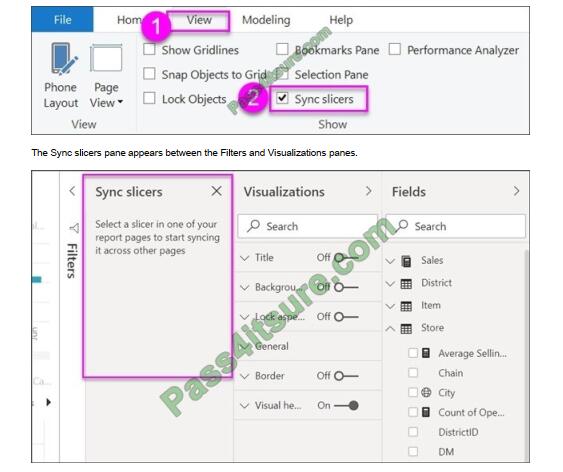
Reference:
https://docs.microsoft.com/en-us/power-bi/create-reports/power-bi-report-add-filter https://docs.microsoft.com/enus/power-bi/visuals/power-bi-visualization-slicers
QUESTION # 4
In Power BI Desktop, you are building a sales report that contains two tables. Both tables have row-level security (RLS) configured. You need to create a relationship between the tables. The solution must ensure that bidirectional cross-filtering honors the RLS settings. What should you do?
A. Create an active relationship between the tables and select Assume referential integrity.
B. Create an inactive relationship between the tables and select Assume referential integrity.
C. Create an inactive relationship between the tables and select Apply security filter in both directions.
D. Create an active relationship between the tables and select Apply security filter in both directions.
Correct Answer: D
By default, row-level security filtering uses single-directional filters, whether the relationships are set to single direction or bi-directional. You can manually enable bi-directional cross-filtering with row-level security by selecting the relationship and checking the Apply security filter in both directions checkbox. Select this option when you\’ve also implemented dynamic row-level security at the server level, where row-level security is based on username or login ID.

Reference: https://docs.microsoft.com/en-us/power-bi/admin/service-admin-rls
QUESTION # 5
You have sales data in a star schema that contains four tables named Sales, Customer, Date, and Product.
The Sales table contains purchase and ship dates. Most often, you will use the purchase date to analyze the data, but you will analyze the data by both dates independently and together.
You need to design an imported dataset to support the analysis. The solution must minimize the model size and the number of queries against the data source. Which data modeling design should you use?
A. Use the Auto Date/Time functionality in Microsoft Power BI and do NOT import the Date table.
B. Duplicate the Date query in Power Query and create active relationships between Sales and both Date tables in the modeling view.
C. On the Date table, use a reference query in Power Query and create active relationships between Sales and both Date tables in the modeling view.
D. Import the Date table twice in Power Query and create active relationships between Sales and both Date tables in the modeling view.
Correct Answer: D
Microsoft recommends defining active relationships whenever possible. They widen the scope and potential of how your model can be used by report authors, and users working with QandA. Refactoring methodology (example): Here\\’s a methodology to refactor a model from a single role-playing dimension-type table, to a design with one table per role.
1. Remove any inactive relationships.
2. Consider renaming the role-playing dimension-type table to better describe its role. In the example, the Airport table is related to the ArrivalAirport column of the Flight table, so it\\’s renamed as Arrival Airport.
3. Create a copy of the role-playing table, providing it with a name that reflects its role. If it\\’s an Import table, we recommend defining a calculated table. If it\\’s a DirectQuery table, you can duplicate the Power Query query. Only one relationship can be active.
Note: If you query two or more tables at the same time, when the data is loaded, Power BI Desktop attempts to find and create relationships for you. The relationship options Cardinality, Cross filter direction, and Make this relationship active are automatically set.
Reference: https://docs.microsoft.com/en-us/power-bi/transform-model/desktop-create-and-manage-relationships
https://docs.microsoft.com/en-us/power-bi/guidance/relationships-active-inactive
QUESTION # 6
You use an R visual to produce a map of 500,000 customers. You include the values of CustomerID, Latitude, and Longitude in the fields sent to the visual. Each customer ID is unique.
In powerbi.com, when users load the visual, they only see some of the customers. What is the cause of the issue?
A. The visual was built by using a different version of R.
B. The data comes from a Microsoft SQL Server source.
C. The data is deduplicated.
D. Too many records were sent to the visual.
Correct Answer: D
R visuals in the Power BI service have a few limitations including:
Data size limitations ?data used by the R visual for plotting is limited to 150,000 rows. If more than 150,000 rows are selected, only the top 150,000 rows are used and a message is displayed on the image.
Additionally, the input data has a limit of 250 MB.
Reference:
https://docs.microsoft.com/en-us/power-bi/visuals/service-r-visuals
QUESTION # 7
Note: This question is part of a series of questions that present the same scenario. Each question in the series contains a unique solution that might meet the stated goals. Some question sets might have more than one correct solution, while others might not have a correct solution.
After you answer a question in this section, you will NOT be able to return to it. As a result, these questions will not appear in the review screen, You create a parameter named DataSourceExcel that holds the file name and location of a Microsoft Excel data source.
You need to update the query to reference the parameter instead of multiple hard-coded copies of the location within each query definition. Solution: In the Power Query M code, you replace references to the Excel file with DataSourceExcel. Does this meet the goal?
A. Yes
B. No
Correct Answer: B
Instead modify the source step of the queries to use DataSourceExcel as the file path.
Note: Parameterising a Data Source could be used in many different use cases. From connecting to different data sources defined in Query Parameters to load different combinations of columns.
Reference:
https://www.biinsight.com/power-bi-desktop-query-parameters-part-1/
QUESTION # 8
DRAG DROP
You have a query named Customer that imports CSV files from a data lake. The query contains 500 rows as shown in the exhibit. (Click the Exhibit tab.)
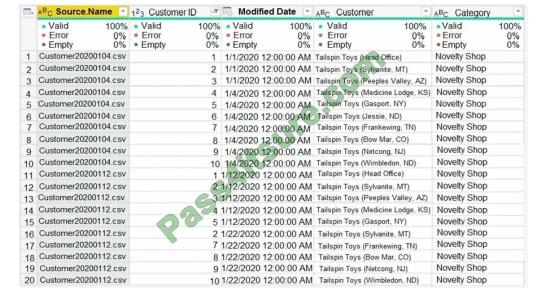
Each file contains deltas of any new or modified rows from each load to the data lake.
Multiple files can have the same customer ID. You need to keep only the last modified row for each customer ID. Which three actions should you perform in sequence? To answer, move the appropriate actions from the list of actions to the answer area and arrange them in the correct order.
Select and Place
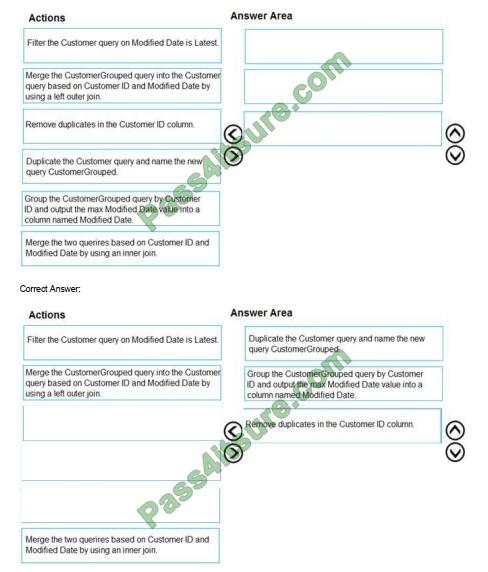
QUESTION # 9
Note: This question is part of a series of questions that present the same scenario. Each question in the series contains a unique solution that might meet the stated goals. Some question sets might have more than one correct solution, while others might not have a correct solution.
After you answer a question in this section, you will NOT be able to return to it. As a result, these questions will not appear in the review screen. You are modeling data by using Microsoft Power Bl. Part of the data model is a large Microsoft SQL Server table named Order that has more than 100 million records.
During the development process, you need to import a sample of the data from the Order table.
Solution: You write a DAX expression that uses the FILTER function.
Does this meet the goal?
A. Yes
B. No
Correct Answer: B
The filter is applied after the data is imported. Instead add a WHERE clause to the SQL statement.
Reference: https://docs.microsoft.com/en-us/power-bi/connect-data/service-gateway-sql-tutorial
QUESTION # 10
What is the minimum number of datasets and storage modes required to support the reports? (What is the minimum number of Power BI datasets needed to support the reports?)
A. two imported datasets
B. a single DirectQuery dataset
C. two DirectQuery datasets
D. a single imported dataset
Correct Answer: A
Scenario: Data and Sources Data for the reports comes from three sources. Detailed revenue, cost, and expense data comes from an Azure SQL database. Summary balance sheet data comes from Microsoft Dynamics 365 Business Central. The balance sheet data is not related to the profit and loss results, other than they both relate dates.
Monthly revenue and expense projections for the next quarter come from a Microsoft SharePoint Online list. Quarterly projections relate to the profit and loss results by using the following shared dimensions: date, business unit, department, and product category.
Reference: https://docs.microsoft.com/en-us/power-bi/connect-data/service-datasets-understand
QUESTION # 11
You need to create a visualization that compares revenue and cost over time. Which type of visualization should you use?
A. stacked area chart
B. donut chart
C. line chart
D. waterfall chart
Correct Answer: C
A line chart or line graph displays the evolution of one or several numeric variables. Data points are connected by straight line segments. A line chart is often used to visualize a trend in data over intervals of time ?a time series ?thus the line is often drawn chronologically.
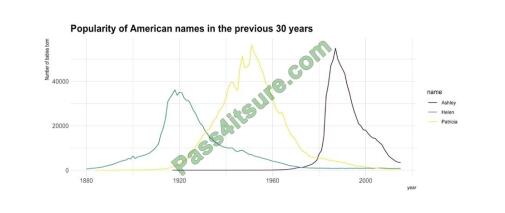
Reference: https://www.data-to-viz.com/graph/line.html
QUESTION 12 #
You have the tables shown in the following table.
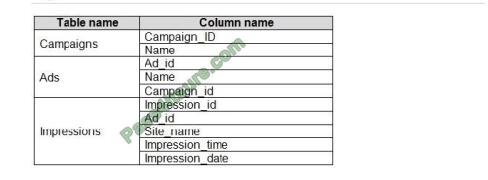
The Impressions table contains approximately 30 million records per month. You need to create an ad analytics system to meet the following requirements:
1. Present ad impression counts for the day, campaign, and Site_name. The analytics for the last year are required.
2. Minimize the data model size.
Which two actions should you perform? Each correct answer presents part of the solution.
NOTE: Each correct selection is worth one point.
A. Group the impressions by Ad_id, Site_name, and Impression_date.Aggregate by using the CountRows function.
B. Create one-to-many relationships between the tables.
C. Create a calculated measure that aggregates by using the COUNTROWS function.
D. Create a calculated table that contains Ad_id, Site_name, and Impression_date.
Correct Answer: AB
QUESTION # 13
You have a prospective customer list that contains 1,500 rows of data. The list contains the following fields:
1. First name
2. Last name
3. Email address
4. State/Region
5. Phone number
You import the list into Power Query Editor. You need to ensure that the list contains records for each State/Region to which you want to target a marketing campaign. Which two actions should you perform? Each correct answer presents part of the solution. NOTE: Each correct selection is worth one point.
A. Open the Advanced Editor.
B. Select Column quality.
C. Enable Column profiling based on entire dataset.
D. Select Column distribution.
E. Select Column profile.
Correct Answer: DE
Data Profiling, Quality and Distribution in Power BI / Power Query features To enable these features, you need to go to the View tab a Data Preview Group a Check the following:
1. Column quality
2. Column profile
3. Column distribution
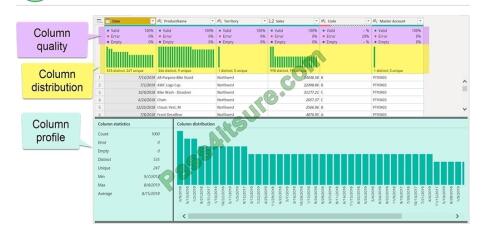
Column profile
Turn on the Column Profiling feature.
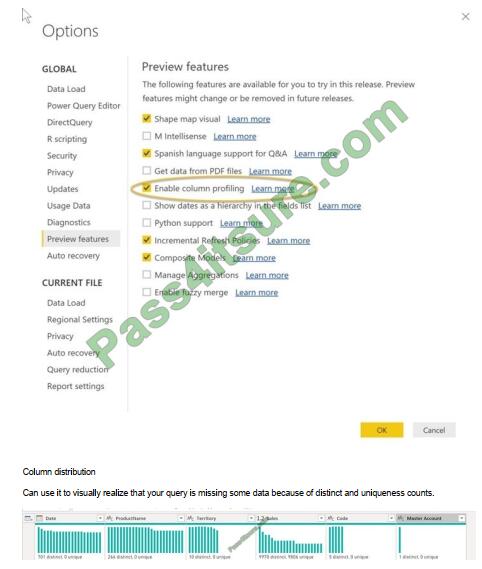
Reference:
https://www.poweredsolutions.co/2019/08/13/data-profiling-quality-distribution-in-power-bi-power-query/
https://www.altentertraining.com/microsoft/power-bi/column-profiling-is-good/
To read more PL-300 exam questions, click here.
Or you can download a free PL-300 dumps online: https://drive.google.com/file/d/1naBvh1XArb04ZfyHWr8SGelKAHGyJghI/view?usp=sharing